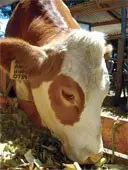AT A RECENT Ol Kalou Agricultural Fair, in Kenya’s Highlands, one stand elicited much interest to the local farming community. A recently introduced German dual purpose breed Fleckvieh became a darling of local dairy farmers.They have been seeking information on how they can introduce it to their herds.
Other farmers traveled from as far as Nyeri, Kirinyaga and Kiambu over 50 km away to get vital information of this recently introduced breed.
Coming from high potential, milk producing Nyandarua district, Ol Kalou farmers are known for their enterprising dairying spirit. “Increasingly, the genetic pool in the dairy sector in this country seems to have constricted over the years and the likelihood of inbreeding has become common. We are now seeking newly introduced breeds to upgrade our existing herd”, said Mr. Alfred Karanja, a successful dairy farmer from Limuru in Kiambu. Reports show that the Central Artificial Insemination Station in Kabete- where most of the locally produced semen is sourced- has only three bulls.
This has made enterprising dairy farmers look beyond borders for imported semen which is prohibitively expensive. Karanja also added that while the Holstein/Friesian breed was good for milk production, its feed intake was ‘too high’ for most smallholder farmers who produce over 80 per cent of the milk produced in the country. “Friesian also have a higher somatic cell count in milk compared to Fleckvieh which makes it prone to mastitis, a common disease among the high producing dairy cows”, he noted.
Eight cows at Mr. Karanja’s farm are already in-calf (pregnant) having been inseminated with Fleckvieh semen a few months ago. In Limuru area, according to Mr. Karanja, at least 450 cows belonging to 180 farmers have been inseminated using the semen for upgrading purposes. Another aspect in dairy production A dual purpose breed, Fleckvieh has introduced another aspect in dairy production.
“We can now raise and fatten bull calves rather than selling them off immediately they were born, which adds value to overall dairy enterprise. The calves also grow quite fast picking 300 kg within 6 months”, said Mr. Jared Kinyosi, a successful farmer in Dandora, just outside capital city Nairobi, as he talked to farmers at the Ol Kalou fair. He is among the farmers in the country who have inseminated their dairy herds with the Fleckvieh semen. Available information indicates that the breed has a high feed conversion efficiency which means it will add weight and produce milk, even while feeding on poor quality pastures.
Experts say that the introduction of new genetic resources into the existing pool will boost production especially with the dairy farmers. “It is time local smallholder farmers changed to reap from their herds betters yields in meat and milk. Ranchers, keeping mostly beef animals, will also be able to earn more with the increased milk production”, said Dr John Wanangwe, a veterinary surgeon with the Fleckvieh Genetics (EA) Ltd, the firm behind the breed introduction in Kenya. Since the introduction of the breed mid-2009, at least 2000 dairy farmers nationally have received the Fleckvieh semen according to Dr Wanangwe, with the half the number coming from Central Province. “We started off in Central Province and we are expanding to other parts of the country. A large number of farmers seeking information on the breed shows interest in the need to upgrade local herds”, he added. Semen costs US$23 to US$54 per insemination.
“The various charges depends on the bulls from which semen has been obtained. For the young unproven bulls, semen is cheaper. For the top bulls – older and proven through consequent breeding, their semen is slightly costly as confidence in performance almost hits 90 per cent”, observed the vet surgeon. He added that it will take 98 months (8 years) in breeding to obtain 94 per cent Fleckvieh pedigree if good management practices are followed. Dr Wanangwe said that the first calves in the country are expected to born from January 2010 and that crossing the breed with the Holstein/Friesian produces the best results for the local dairy farmers. Another good attribute of the breed is its resistance to tropical diseases and harsh weather in the arid and semi-arid regions.
“In South Africa and Namibia- where the breed has been raised for years, it has been found better suited to harsh conditions that the Improved Boran. It also produces 30 litres of milk daily coming second only to Holstein/ Friesian”, said Dr. Wanangwe. Smallholder dairy farmers in the country lament on their inability to meet the ever rising demand for milk locally and for export markets. “While land acreage is shrinking affecting milk production due to reduced area under fodder and pastures, improvement on genetics is the only way to keep milk production high. We need superior semen which will in turn lead to good milk producing heifers”, said Mrs. Jane Kamau, a farmer from Tumaini, in Ol Kalou division. The Fleckvieh breed started off 170 years ago when the original Simmental cattle from Switzerland were imported to Bavaria, Germany to upgrade local dual purpose breeds. Today, big populations of the breed are found in South Africa, Namibia, Europe, South America, New Zealand and Australia.








